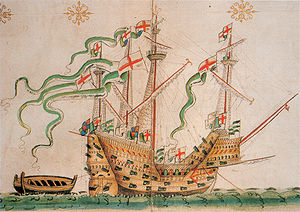Peter Pomegranate
 Peter Pomegranate as depicted in the Anthony Roll.
| |
| History | |
|---|---|
| Name | Peter Pomegranate(from 1536 Peter) |
| Builder | Portsmouth |
| Launched | 1510 |
| Commissioned | 1510 |
| Refit | rebuilt and enlarged 1536 |
| Honours and awards | |
| Fate | Unknown, last mentioned in 1558 |
| General characteristics | |
| Tons burthen | 600 |
| Complement | 185 soldiers, 185 sailors, 30 gunners |
| Armament | 36 cannons, 66 swivel guns |
Peter Pomegranate was a warship of the English Tudor navy, build in 1510. Her name most likely was in honour of Saint Peter and the badge of Queen Catharine of Aragon, a pomegranate.[1] She had a tonnage of 450 when first built, but in 1536 she was rebuilt and enlarged to a tonnage of 600; at that date the name was shortened to Peter (Catharine had fallen out of grace; she died in 1536). The ship's fate is not recorded, but she was last mentioned in records in 1558.[2] Peter Pomegranate was a contemporary of Mary Rose that sank during the Battle of the Solent in 1545.
Named in full in the roster as "Peter Pomgarnarde", she joined Edward Clinton's invasion fleet against Scotland in August 1547.[3] According to an inventory of 1547, the rebuilt Peter had 185 sailors, 185 soldiers, and 30 gunners. Her armaments included; 2 brass demi-cannons; 2 brass culverins; 4 brass demi-culverins; 4 brass sakers; an iron culverin; 3 iron sakers; 9 iron port pieces; 37 iron bases; and 11 hagbuts. There were also 259 yew bows, 160 bills; and 160 Moorish pikes.[4]
References
- ^ Childs, David, The Warship Mary Rose: The Life and Times of King Henry VIII's Flagship Chatham Publishing, London. 2007. ISBN 978-1-86176-267-2, p. 17; Marsden, Peter (editor), Your Noblest Shippe: Anatomy of a Tudor Warship. The Archaeology of the Mary Rose, Volume 2. The Mary Rose Trust, Portsmouth. 2009. ISBN 978-0-9544029-2-1, pp. 5, 379
- ^ Rodger, N. A. M. (2004). The Safeguard of the Sea. London: Penguin Books. pp. 476–477. ISBN 0-14-029724-3.
- ^ Calendar of State Papers Scotland, vol. 1 (1898), 12, no. 29.
- ^ Starkey, David, ed., Inventory of Henry VIII, vol 1, Society of Antiquaries (1998), nos. 7165, 7252-7273.
